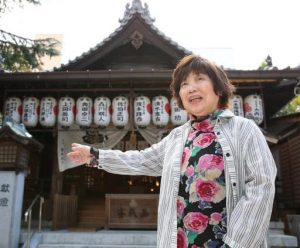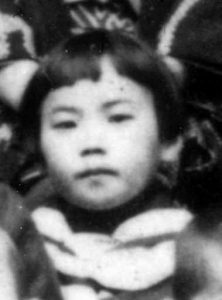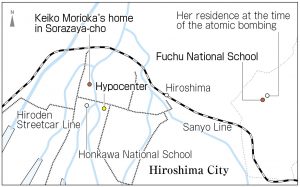Survivors’ Stories: Keiko Morioka, 84, Naka Ward, Hiroshima—Continued search for friend Midori
Nov. 2, 2020
by Kyoko Niiyama, Staff Writer
During World War II, Keiko Morioka would play with her friend Midori, who used to help her with her homework. Midori was three years older than Ms. Morioka, who is now 84. When Ms. Morioka left Hiroshima to live in a safer place under evacuation orders, the two friends promised they would see each other again. After the atomic bombing, however, she could not obtain any information about Midori’s whereabouts. Sometime after the war, she found out that Midori had died in the atomic bombing. Ms. Morioka’s sorrow has not abated even 75 years later.
In those days, Ms. Morioka lived next to Sorasayainao Shrine in Hiroshima’s present-day, centrally located Naka Ward. Children would play on the shrine’s grounds, where their boisterous voices could always be heard. Midori Tomoyanagi and her family lived in a house a few doors down from Ms. Morioka. Ms. Morioka used to visit her at her house, and Midori would always graciously teach her origami and mathematics.
When Ms. Morioka would sometimes become absorbed in catching shrimp in the nearby Honkawa River and forget the time, Midori always came for her as if she were her sister. She has countless fond memories. “She was a caring person, and I admired her.
In April 1943, Ms. Morioka entered the Honkawa National School (now Honkawa Elementary School). An entrance ceremony was held at Sorasayainao Shrine to pray for victory in the war. In April 1945, when Ms. Morioka became a third grader, she evacuated from Hiroshima for safety and moved to her aunt’s house in the town of Fuchu with her mother, younger sister, and brother. Midori hugged Ms. Morioka and said, “We’ll meet again soon.”
Ms. Morioka made friends at Fuchu National School right away. She said she enjoyed living in a place amid rich natural beauty even though it was during the war.
On August 6, after a morning assembly at school, she was walking up the stairs to return to her classroom on the second floor. When she looked out the window in a hallway, she saw a plane flying low in the direction of central Hiroshima. She and her classmates leaned out of the windows and said, “It’ll be shot down with artillery.” Suddenly, however, an intense flash of light filled the air, and the blast from the explosion broke the windows with a crash. There were screams and crying all around her. She felt a searing pain in one of her eyes but managed to catch a glimpse of the mushroom cloud boiling upward into the sky.
Her school, which served as a temporary first-aid station, filled with people who had fled Hiroshima. Ms. Morioka and other students’ textbooks kept at the school were used to wipe the blood of the injured. Her two cousins, who were at a munitions factory in Hiroshima, also fled to Fuchu. Their bodies were covered with blood, since they had been wounded by shattered glass, and their wounds became infested with maggots.
On August 17, 11 days after the atomic bombing, Ms. Morioka and her grandmother made the journey to Hiroshima in search of her uncle. The area of Sorazaya-cho, about 660 meters from the hypocenter, had been burned to the ground, making it impossible for them to find his remains. Neither was it possible to find out about Midori’s whereabouts. Corpses were being incinerated here and there, emitting a horrible odor. After she returned to Fuchu, Ms. Morioka grew ill, vomiting numerous times.
Following the war, Ms. Morioka continued to hope that Midori might be alive. She would sometimes bicycle around to check the lists of victims posted in the city. In 2002, the Hiroshima National Peace Memorial Hall for the Atomic Bomb Victims opened in Hiroshima Peace Memorial Park. When she went there to check the list of registered victims, she found Midori’s name and learned that she had died in Sorazaya-cho on August 6. “I was prepared, but it was still hard to be confronted with that reality.”
Ms. Morioka later attended a university in Hiroshima. She married and had two children. In her early 50s, she opened a beauty salon in central Hiroshima, where she still works.
Ms. Morioka put her childhood memories and experience of the atomic bombing in writing for the first time this summer. At Honkawa National School, the closest school to the hypocenter, many children died. “If I had not been evacuated…,” she wrote. She feels as if her life was given to her by the support she received from people around her. As she continued to write, she came to feel stronger. “We do not need nuclear weapons, which kill innocent children.”
Days filled with smiles are really precious
Midori was like a family member for Ms. Morioka, but it was many years after the atomic bombing that she learned about Midori’s death. The death itself of a person close to you is hard. Learning that the person had been dead for many years would likely make me lose the will to live, because I would not be able to accept the death. I feel that living every day happily with my family is truly precious. (Riko Soma, 12)
Always express gratitude
Because of the coronavirus pandemic, my junior high school closed right before we were to graduate. I have not had a chance to thank my classmates and teachers for what they did for me. Ms. Morioka never imagined she would not be able to see Midori again. I feel as if I should always express my gratitude to the people around me. (Hitoha Katsura, 16)
(Originally published on November 2, 2020)
Found Midori’s name among those of victims in 2002
“I was prepared, but it was still hard”
During World War II, Keiko Morioka would play with her friend Midori, who used to help her with her homework. Midori was three years older than Ms. Morioka, who is now 84. When Ms. Morioka left Hiroshima to live in a safer place under evacuation orders, the two friends promised they would see each other again. After the atomic bombing, however, she could not obtain any information about Midori’s whereabouts. Sometime after the war, she found out that Midori had died in the atomic bombing. Ms. Morioka’s sorrow has not abated even 75 years later.
In those days, Ms. Morioka lived next to Sorasayainao Shrine in Hiroshima’s present-day, centrally located Naka Ward. Children would play on the shrine’s grounds, where their boisterous voices could always be heard. Midori Tomoyanagi and her family lived in a house a few doors down from Ms. Morioka. Ms. Morioka used to visit her at her house, and Midori would always graciously teach her origami and mathematics.
When Ms. Morioka would sometimes become absorbed in catching shrimp in the nearby Honkawa River and forget the time, Midori always came for her as if she were her sister. She has countless fond memories. “She was a caring person, and I admired her.
In April 1943, Ms. Morioka entered the Honkawa National School (now Honkawa Elementary School). An entrance ceremony was held at Sorasayainao Shrine to pray for victory in the war. In April 1945, when Ms. Morioka became a third grader, she evacuated from Hiroshima for safety and moved to her aunt’s house in the town of Fuchu with her mother, younger sister, and brother. Midori hugged Ms. Morioka and said, “We’ll meet again soon.”
Ms. Morioka made friends at Fuchu National School right away. She said she enjoyed living in a place amid rich natural beauty even though it was during the war.
On August 6, after a morning assembly at school, she was walking up the stairs to return to her classroom on the second floor. When she looked out the window in a hallway, she saw a plane flying low in the direction of central Hiroshima. She and her classmates leaned out of the windows and said, “It’ll be shot down with artillery.” Suddenly, however, an intense flash of light filled the air, and the blast from the explosion broke the windows with a crash. There were screams and crying all around her. She felt a searing pain in one of her eyes but managed to catch a glimpse of the mushroom cloud boiling upward into the sky.
Her school, which served as a temporary first-aid station, filled with people who had fled Hiroshima. Ms. Morioka and other students’ textbooks kept at the school were used to wipe the blood of the injured. Her two cousins, who were at a munitions factory in Hiroshima, also fled to Fuchu. Their bodies were covered with blood, since they had been wounded by shattered glass, and their wounds became infested with maggots.
On August 17, 11 days after the atomic bombing, Ms. Morioka and her grandmother made the journey to Hiroshima in search of her uncle. The area of Sorazaya-cho, about 660 meters from the hypocenter, had been burned to the ground, making it impossible for them to find his remains. Neither was it possible to find out about Midori’s whereabouts. Corpses were being incinerated here and there, emitting a horrible odor. After she returned to Fuchu, Ms. Morioka grew ill, vomiting numerous times.
Following the war, Ms. Morioka continued to hope that Midori might be alive. She would sometimes bicycle around to check the lists of victims posted in the city. In 2002, the Hiroshima National Peace Memorial Hall for the Atomic Bomb Victims opened in Hiroshima Peace Memorial Park. When she went there to check the list of registered victims, she found Midori’s name and learned that she had died in Sorazaya-cho on August 6. “I was prepared, but it was still hard to be confronted with that reality.”
Ms. Morioka later attended a university in Hiroshima. She married and had two children. In her early 50s, she opened a beauty salon in central Hiroshima, where she still works.
Ms. Morioka put her childhood memories and experience of the atomic bombing in writing for the first time this summer. At Honkawa National School, the closest school to the hypocenter, many children died. “If I had not been evacuated…,” she wrote. She feels as if her life was given to her by the support she received from people around her. As she continued to write, she came to feel stronger. “We do not need nuclear weapons, which kill innocent children.”
Teenagers’ impressions
Days filled with smiles are really precious
Midori was like a family member for Ms. Morioka, but it was many years after the atomic bombing that she learned about Midori’s death. The death itself of a person close to you is hard. Learning that the person had been dead for many years would likely make me lose the will to live, because I would not be able to accept the death. I feel that living every day happily with my family is truly precious. (Riko Soma, 12)
Always express gratitude
Because of the coronavirus pandemic, my junior high school closed right before we were to graduate. I have not had a chance to thank my classmates and teachers for what they did for me. Ms. Morioka never imagined she would not be able to see Midori again. I feel as if I should always express my gratitude to the people around me. (Hitoha Katsura, 16)
(Originally published on November 2, 2020)










